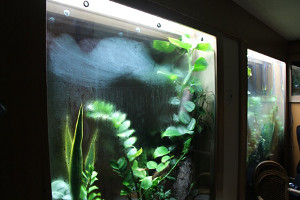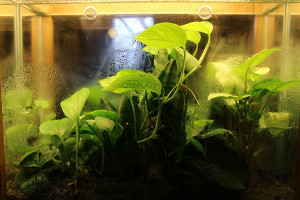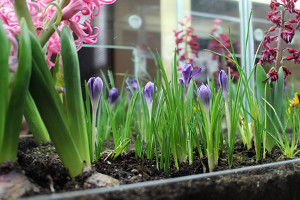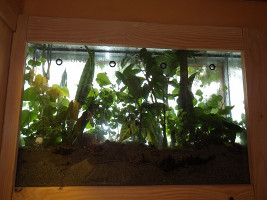People are spending more and more time indoors, upwards of 80 and 90 percent. Many buildings that we work and live in include the heating, ventilation and air conditioning systems (HVAC) for refreshing interior air. This is done by mechanically drawing exterior air into the building from the outside of the building to replace the interior air. However, when exterior air is drawn in a building, airborne pollutants are often drawn into the building as well.

In an effort to increase energy efficiency, many buildings are being designed and built to be substantially airtight. Substantially airtight buildings restrict or prevent the movement of indoor airborne pollutants to outside of the building.
The building themselves may also contribute to the levels of indoor airborne pollutants. For example, volatile organic compounds are known to be released by various building materials. Furthermore, some buildings may harbour fungus, moulds, bacteria and other potentially toxic microorganisms that can become airborne within the building. Some estimates indicate that levels of airborne pollutants within interior air may be many times higher than the exterior air.
The combination of indoor airborne contaminants and the large amount of time that people are spending indoors has been linked to Sick Building Syndrome (see United States Environmental Protection Agency Air and Radiation Research and Development (MD-56) February 1991). Sick Building Syndrome is the reported incidence of various physical symptoms that are associated with time spent indoors.

The physical symptoms of Sick Building Syndrome may include, one or more of: headache, dizziness, nausea, irritation of one or both eyes, nose or throat, dry cough, dry or itchy skin, difficulties with concentration, fatigue, sensitivity to odors, hoarse voice, allergies, colds, flu-like symptoms, increased incidence of asthma attacks and personality changes (see Sumedha Joshi in Indian J Occup Environ Med. Aug 2008; 12(2): 61–64).
The physical symptoms often resolve themselves partially when the patient simply leaves the building, only to come back upon the patient’s return to the building. Sick Building Syndrome may negatively affect work place efficiency and the psychological environment of the workplace. Furthermore, poor indoor air quality has been reported to negatively affect workforce production by approximately $60 billion per year in USA (see Reitze Arnold, “The Legal Control of Indoor Air Pollution”, The Boston College Environmental Affairs Law Review, 1998).
We are constantly being negatively impacted by indoor air pollution. This includes toxic fumes such as formaldehyde, VOCs, trichloroethylene, carbon monoxide, benzene, toluene, xylene, and countless others.
Information about common indoor air toxins.
VOC’s or volatile organic compounds
VOC’s are found in all petroleum products; however there are many other sources such as flooring adhesives (used for carpeting, hardwoods, etc), paint, furniture, wall materials, electronic equipment, cigarette smoke, household cleaning products and even air fresheners!
The main reason we should be worried about VOCs is because they are the primary precursor to the formation of ground level ozone and particulate matter in the atmosphere which are the main ingredients of the air pollutant referred to as smog. The negative health effects of smog are well documented.
Trichloroethylene (TCE)
TCE is a common indoor pollutant being released from paints, dry cleaning, adhesives, pesticides and the ink in copy machines, faxes, and printers. Short-term exposure to TCE causes irritation of the nose and throat and depression of the central nervous system. Higher concentrations have caused numbness and facial pain, reduced eyesight, unconsciousness, irregular heartbeat and even death.
Carbon monoxide (CO)
CO is a dangerous gas which is produced from open fires, gas stoves, appliances and heaters. It is also present in high concentrations in cigarette smoke and vehicle exhaust. Low level exposure causes dizziness and headaches while more acute exposure can lead to death because CO actually prevents the delivery of oxygen to the body's cells.
Benzene (C6H6), Toluene (C7H8) and Xylene (C8H10)
These pollutants are found in the vapour of products such as gasoline, oils, paints, glues, inks, plastics, and rubber, where they are used as solvents. They are used in the composition of detergents, explosives, pharmaceuticals, foams and dyes. They are skin and eye irritants and are known carcinogens. These carcinogens are in connection to human leukemia.
How Terra Living Walls can help
So how does this all relate to Terra Living Walls, you may ask. Well, research undertaken by the National Aeronautics and Space Administration (NASA) proves that plants are capable of cleaning indoor air of the toxic chemical soup that is common in modern buildings.
Dr. William Wolverton, NASA's principal investigator researching air quality on space stations, stated that chemicals such as formaldehyde and carbon monoxide can be removed from indoor environments by the plant leaves alone. VOCs, TCE, benzene, toluene, xylene and numerous other toxic chemicals can be removed by the roots of plant (or by the microorganisms living around the roots which degrade and assimilate these chemicals).

The good news is that all plants absorb and clean pollutants from the air. Certain tropical species are more efficient than others. Terra Living Wall systems utilize hundreds of different plants that could improve air quality inside the room. A Terra Living Walls can contain variety of plants, all of which filter air and in addition create energy-rich oxygen.
The chart below lists toxic chemicals commonly found inside buildings and just a few examples of Terra Living Walls plants which are the most efficient at absorbing and neutralizing them.
| Common indoor toxic chemical | Terra Living Walls plants best at removing these toxins |
|---|---|
| Formaldehyde (CH2O) |
|
| Carbon Monoxide (CO) |
|
| Volatile Organic Compounds (VOCs) |
|
| Trichloroethylene (TCE) |
|
| Benzene (C6H6) / Toluene (C7H8) / Xylene (C8H10) |
|
Toxic chemicals and the tropical (Terra Living Walls) plant species which are best at removing them. Adapted from Dr. B.C. Wolverton's book - How to Grow Fresh Air, 1996.
Through the process of photosynthesis, plants take in carbon dioxide (CO2) and release oxygen (O2). An increase in oxygen helps to keep us awake and alert.

Another advantage of having a Terra Living Walls is that it saves a lot of space due to utilizing existing wall space compare to modular and other living wall systems. If the same number of plants that we use in Terra Living Walls were growing in pots on your floor you could probably fill your whole house! You will benefit from a dramatic increase in air filtration and oxygen production and do so using much less valuable floor space.
According to the Environmental Protection Agency, “people living and working in buildings of man-made materials inhale over 300 contaminants every day.” Concerns about these contaminants arise from the hypothesis that, when combined, the toxicity of hundreds of different chemicals can "add up" to create major health hazards.